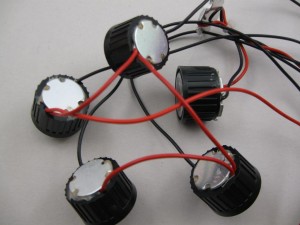LEDs and Wiring
 This image shows a set of four (+1) 3W LEDs in 15-degree lenses ready to be mounted to form a rotating beacon. This image shows a set of four (+1) 3W LEDs in 15-degree lenses ready to be mounted to form a rotating beacon.
LED voltage and current
LEDs operate on current, not voltage. You apply a voltage, if it is high enough current will flow, making the LED light, and heat up. The series connected resistor limits the current to a level that the LED can withstand. The voltage measured across the LED doesn’t matter except for power calculations. V x A = Watts.
Using a fixed resistor value and a voltage supply works best if the supply voltage is steady. Not always the case with battery power. Constant-Current drivers are best, but more complex and more complex to configure when using assorted LEDs.
Wire sizes depend on more on length as currents are not too high. Typical servo wire is usually OK. For large models where the LEDs may be spread out, you should increase the wire size slightly for the larger LEDs. 0.5mm flexible cable is good. The twisted Red-Blue wiring above is 0.5mm.
Typical RC 3W White LED
I tested a Hobbyking 3W white LED (28504). These have a small metal heatsink disk and a short lead with servo connector attached.
It only just starts to glow at 2.4V and gets brighter quickly as the voltage goes up. At the top end the current increases quickly and it gets very hot, even with the small metal heatsink. These tests done with a current limited power supply and temperature read with a IR thermometer (ambient was 24-degC):
- 2.83V @ 100mA 31-degC 0.28 Watts
- 2.93V @ 200mA 40-degC 0.56 W
- 3.02V @ 300mA 52-degC 0.91 W
- 3.07V @ 400mA 59-degC 1.22 W
- 3.15V @ 500mA 73-degC 1.57 W
- 3.29V @ 700mA 93-degC 2.30 W
- 3.41V @ 800mA 122-degC 2.73 W
- 3.42V @ 900mA 143-degC 3.07 Watts (started to smell very hot)
This shows that beyond 1-1.5 Watts, additional heatsinking is a good idea if you don’t want to melt something or start a fire. At the top end, if you do want to run these at 3 watts, using a current limited supply is probably essential to making it reliable..
|